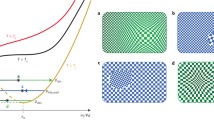Abstract
During reaction, a catalyst surface usually interacts with a constantly fluctuating mix of reactants, products, ‘spectators’ that do not participate in the reaction, and species that either promote or inhibit the activity of the catalyst. How molecules adsorb and dissociate under such dynamic conditions is often poorly understood. For example, the dissociative adsorption of the diatomic molecule H2—a central step in many industrially important catalytic processes—is generally assumed1 to require at least two adjacent and empty atomic adsorption sites (or vacancies). The creation of active sites for H2 dissociation will thus involve the formation of individual vacancies and their subsequent diffusion and aggregation2,3,4,5,6, with the coupling between these events determining the activity of the catalyst surface. But even though active sites are the central component of most reaction models, the processes controlling their formation, and hence the activity of a catalyst surface, have never been captured experimentally. Here we report scanning tunnelling microscopy observations of the transient formation of active sites for the dissociative adsorption of H2 molecules on a palladium (111) surface. We find, contrary to conventional thinking1, that two-vacancy sites seem inactive, and that aggregates of three or more hydrogen vacancies are required for efficient H2 dissociation.




Similar content being viewed by others
References
Conrad, H., Ertl, G. & Latta, E. E. Adsorption of hydrogen on palladium single crystal surfaces. Surf. Sci. 41, 435–446 (1974)
Taylor, H. S. Theory of the catalytic surface. Proc. R. Soc. Lond. A 108, 105–111 (1925)
Boudart, M. Four decades of active centers. Am. Sci. 57, 97–111 (1969)
Ponec, V. & Sachtler, W. M. H. The reactions between cyclopentane and deuterium on nickel and nickel-copper alloys. J. Catal. 24, 250–261 (1972)
Sinfelt, J. H. Bimetallic Catalysts: Discoveries, Concepts and Applications (Wiley and Sons, New York, 1983)
Somorjai, G. A. Introduction to Surface Chemistry and Catalysis (Wiley and Sons, New York, 1994)
Behler, S. et al. A scanning tunneling microscope with continuous flow cryostat sample cooling. Rev. Sci. Instrum. 68, 2479–2485 (1997)
Felter, T. E., Sowa, E. C. & Van Hove, M. A. Location of hydrogen on palladium (111) studied by low-energy electron diffraction. Phys. Rev. B 40, 891–899 (1989)
Paul, J. F. & Sautet, P. Density-functional periodic study of the adsorption of hydrogen on a palladium (111) surface. Phys. Rev. B 53, 8015–8027 (1996)
Lovvik, O. M. & Olsen, R. A. Adsorption energies and ordered structures of hydrogen on Pd(111) from density functional periodic calculations. Phys. Rev. B 58, 10890–10898 (1998)
Mitsui, T., Rose, M. K., Fomin, E., Ogletree, D. F. & Salmeron, M. Hydrogen adsorption and diffusion on Pd(111). Surf. Sci. (submitted)
Acknowledgements
This work was supported by the Office of Basic Energy Science of the US Department of Energy.
Author information
Authors and Affiliations
Corresponding author
Ethics declarations
Competing interests
The authors declare that they have no competing financial interests.
Supplementary information
41586_2003_BFnature01557_MOESM1_ESM.mpg
Supplementary Movie: Hydrogen vacancy diffusion, 180 seconds. In this movie, vacancies appear as bright spots surrounded by dark rings, while the periodic background represents the 1×1 H adlayer. (MPG 552 kb)
Rights and permissions
About this article
Cite this article
Mitsui, T., Rose, M., Fomin, E. et al. Dissociative hydrogen adsorption on palladium requires aggregates of three or more vacancies. Nature 422, 705–707 (2003). https://doi.org/10.1038/nature01557
Received:
Accepted:
Issue Date:
DOI: https://doi.org/10.1038/nature01557
- Springer Nature Limited
This article is cited by
-
Pd3Ag(111) as a Model System for Hydrogen Separation Membranes: Combined Effects of CO Adsorption and Surface Termination on the Activation of Molecular Hydrogen
Topics in Catalysis (2020)
-
The Hydrogen Oxidation Reaction in Alkaline Medium: An Overview
Electrochemical Energy Reviews (2019)
-
Influence of atmospheric oxygen on hydrogen detection on Pd using Kelvin probe technique
Journal of Solid State Electrochemistry (2018)
-
Quantum chemical study of H2 adsorption on Pd21 cluster
Russian Chemical Bulletin (2017)
-
Electrocatalytic dechlorination of 2,3,5-trichlorophenol on palladium/carbon nanotubes-nafion film/titanium mesh electrode
Environmental Science and Pollution Research (2017)





